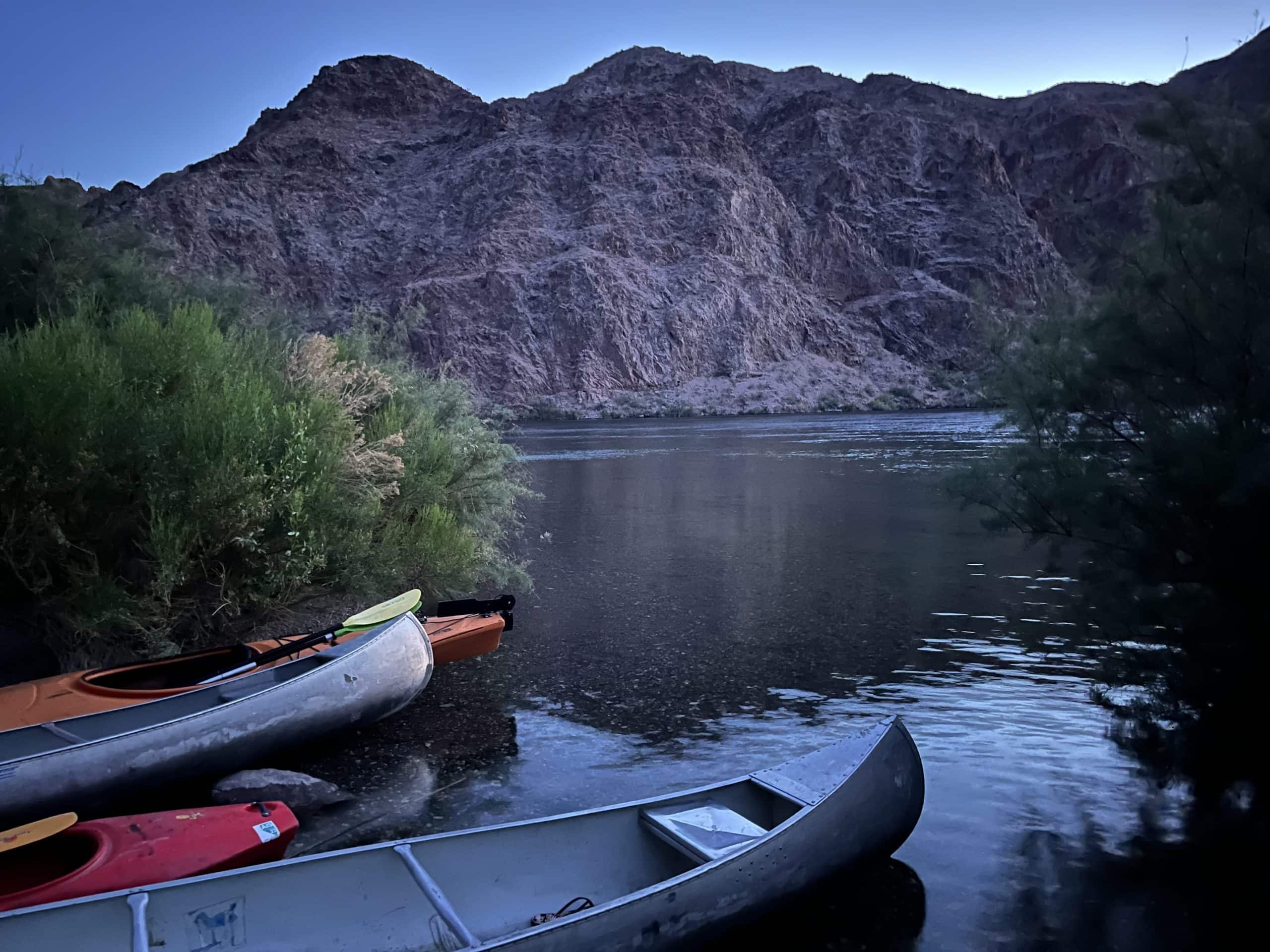Kayaking the Black Canyon: A Self-Guided Adventure
Just 45 minutes from the Las Vegas Strip, we traded neon lights for canyon walls—and slot machines for hot springs, just like we did on our Havasupai backpacking trip. While most people come to Vegas for the shows and casinos, one of the Southwest’s best-kept secrets is hidden just a few miles downriver: a wild, winding stretch of the Colorado River known as the Black Canyon National Water Trail. For those looking to explore it at their own pace, a self guided trip through Black Canyon offers the perfect blend of solitude, hot springs, and desert adventure—without the crowds.
When we started planning our return trip to the desert, Joshua had only one requirement: he wanted to kayak the Colorado. That single wish launched me down a planning rabbit hole in search of the ultimate paddling experience—and I found it in a self-guided kayak trip through Black Canyon.
From hiking to the Confluence of Havasu Creek and the Colorado River to paddling through the slot canyons and hot springs of Black Canyon, our desert adventure was a back-to-back thrill. We explored natural saunas, steamy springs, hidden caves, secluded beaches, and rocky desert scrambles—all while gliding over the emerald-green waters of the Colorado River.
This post contains affiliate links, which means if you make a qualifying purchase after clicking one of my links, I may earn a small commission at no extra charge to you. I only recommend products we use and love or that I believe will add value to your trip. Thank you for supporting my blog.
What is the Black Canyon National Water Trail?
The Black Canyon National Water Trail is a stunning 30-mile stretch of the Colorado River that winds through the rugged, volcanic canyons below Hoover Dam, offering a unique and immersive way to explore the desert southwest by water. Designated as the first National Water Trail in the Southwest U.S., it runs from the base of Hoover Dam to Eldorado Canyon, with the most popular section spanning from the dam to Willow Beach.
Along the way, paddlers encounter emerald green waters, secluded beaches, slot canyons, historic sites, and natural hot springs—all framed by towering canyon walls and dramatic desert landscapes. Accessible only by watercraft, this trail is a haven for kayakers and canoeists seeking a self-guided or guided adventure rich in natural beauty, solitude, and geothermal wonders.
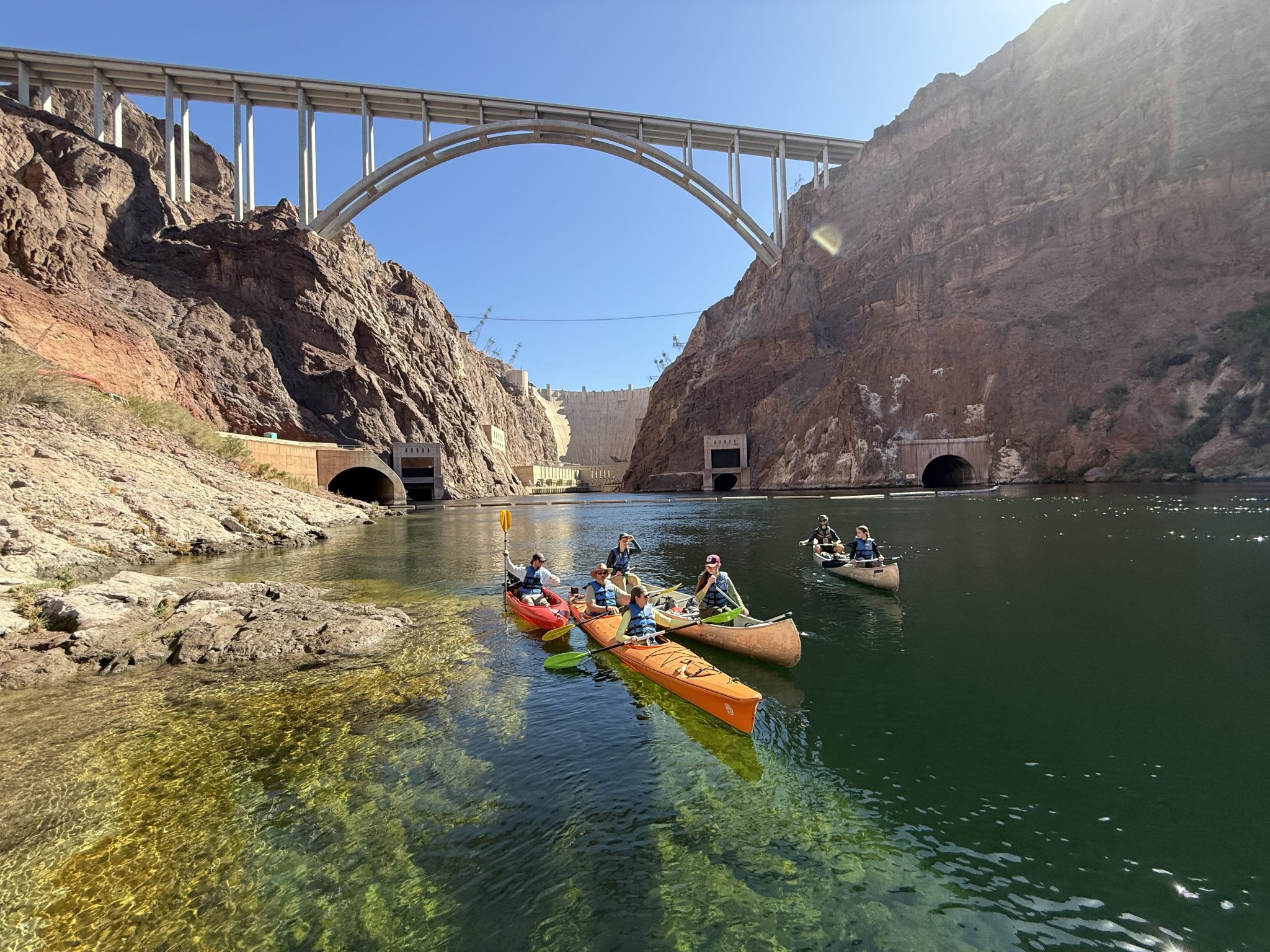
Guided Vs Self Guided
One of the first decisions we had to make was whether we wanted a guided or self-guided trip. Both have their advantages, and there are plenty of solid options either way.
Our group is pretty adventurous, has some experienced paddlers, and prioritizes budget travel—so we chose self-guided. It’s a LOT cheaper, but it’s definitely not for everyone.
We booked our self guided trip through Desert River Outfitters.
Cost: $150 USD/person
Included:
✅ Kayak or canoe for three days
✅ Shuttle to Hoover Dam
✅ Pick up from Willow Beach
✅ PFDs (Must be worn while paddling- federal and state law; fines for noncompliance)
✅ Printed map of the water trail
✅ Assistance unloading and launching at Hoover Dam
❌ Hoover Dam launch fee (nonrefundable, non transferable)
❌ Lake Mead entrance fee
When I first started researching, I was honestly a little nervous. We had never done anything like this as a family before, and paddling through a remote canyon was a whole new kind of adventure for us. I found conflicting advice online about whether beginners should attempt the route without a guide, and I felt anxious trying to make the right call.
After doing it, here’s my take on who will thrive on a self-guided trip through Black Canyon:
✅ You’ll probably do well with self-guided if…
👉 Your group includes at least one experienced paddler per boat.
We had a group of seven: three strong paddlers, an intermediate, and some beginners. That mix worked well—we were able to switch up partners as needed to keep things balanced and moving forward.
👉 Someone in your group knows how to do a T-rescue.
This is key. We know at least two groups capsized on the river during our trip. The water is generally calm, but accidents happen—and if you’re far from help, knowing basic rescue techniques matters.
👉 You’re prepared for wind—and willing to adapt.
The Black Canyon is mostly flatwater, but it can get very gusty. Our first two days were a tough paddle, with strong headwinds and waves. We ended up rearranging our paddling teams to keep things efficient and safe.
👉 You own (or are willing to rent) proper camping gear.
Desert River Outfitters (our outfitter) supplied canoes/kayaks, paddles, PFDs, and round-trip shuttle service. Everything else—food, camp stove, tents, dry bags—was on us.
👉 You value flexibility and traveling at your own pace.
This was probably the biggest win for us. We loved being able to stop wherever we wanted, soak in hot springs without watching the clock, and take our time exploring caves and beaches. No tour group schedule. No pressure.
📌 Pro Tip: There’s no cell service in the Black Canyon. If you’re going self-guided, bring a satellite communicator like the Garmin inReach Mini or Zoleo in case of emergency. It’s peace of mind you’ll be glad to have—especially in such a remote environment.
Garmin inReach- Buy at: REI | Amazon
Zoleo- Buy at REI | Amazon
✅ You should go guided if…
👉 You’re a beginner or have limited paddling experience.
A guide provides instruction, safety support, and reassurance—perfect if you’re new to kayaking or unsure in open water.
👉 You want everything planned and provided.
Tours include gear, safety equipment, snacks, water, and round-trip transport. No need to manage permits, timing, or shuttles.
👉 You want to learn about the geology, wildlife, and history.
Guides often share stories about the canyon, Hoover Dam, hot springs, and desert ecosystems that you might otherwise miss.
👉 You prefer structure and a predictable itinerary.
Guided trips follow a set route and pace, which can be helpful for travellers who like knowing exactly what to expect.
Some Guided Options:
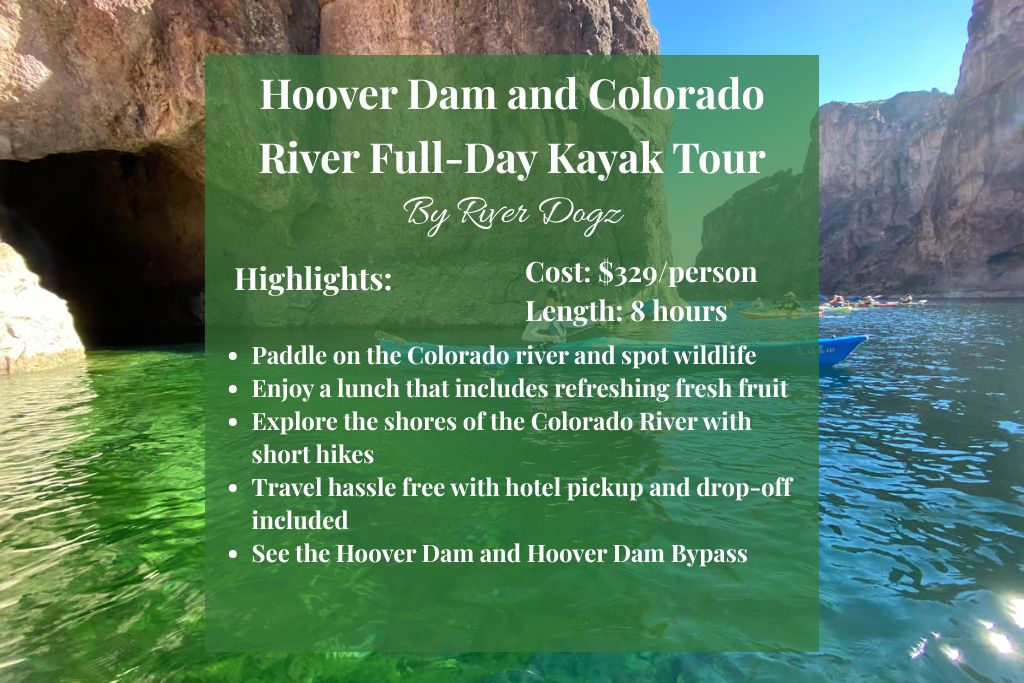
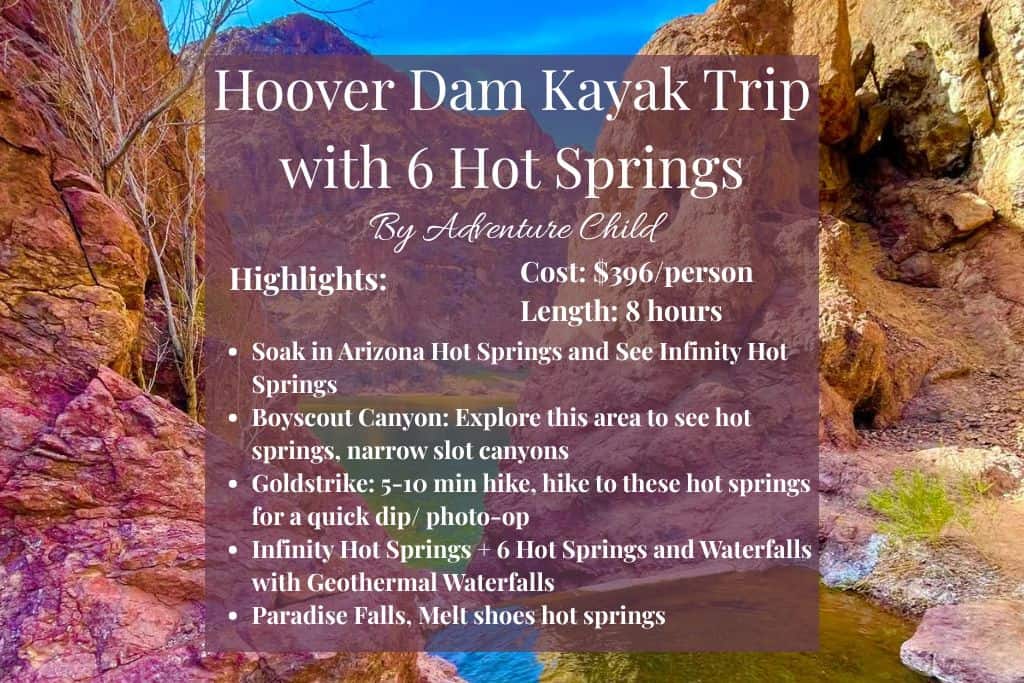
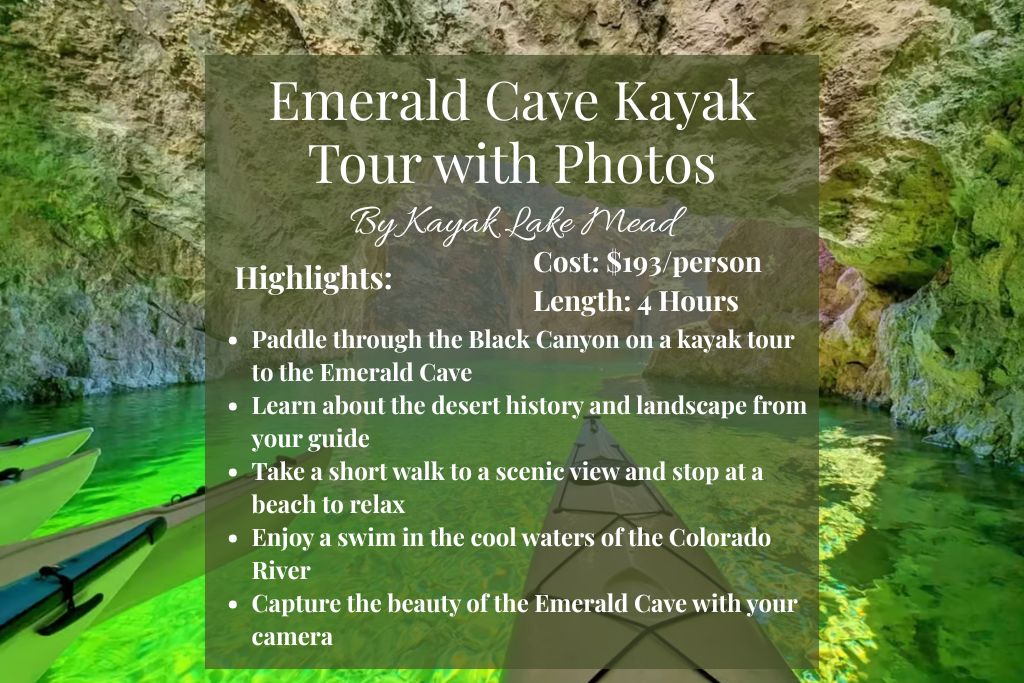
How Many Days are Needed?
The next thing we had to decide was how many days we wanted to go. The Black Canyon can be done as a day trip or over multiple days for both guided and self guided trips.
We knew we wanted to take our time and see as much as we could, so we opted for two nights and three days. With the trail only being 13 miles long, we weren’t sure if this would be too many days, but it turned out to be the perfect length.
Planning Your Trip
A. Permits and Regulations
Trips typically launch from Hoover Dam and continue to Willow Beach. Launching form Hoover Dam requires special permits and security clearance, but your outfitter will take care of those details.
🚨 Quick Myth Buster: You Can Launch Below Hoover Dam on a Self-Guided Trip
One common misconception is that you need to book a guided tour to launch from Hoover Dam—but that’s not true.
Even on our self-guided trip, our outfitter (Desert River Outfitters) took care of everything related to permits, launch access, and Homeland Security clearance. We simply showed up at the designated time, passed through the security checkpoint, and launched right from the base of the dam.
The key is booking through a licensed livery service approved by the Bureau of Reclamation. You can’t show up on your own or drive your own boats to the launch site—but you can go self-guided with the right outfitter.
🎟 Hoover Dam Launch Permits (via Licensed Outfitters)
Required for all paddlers launching below Hoover Dam
- Adults (16+): $32 USD per person
- Youth (15 & under) OR holders of the America the Beautiful pass: $16 USD per person
- Note: Permits are non-refundable, non-transferable, and date/time specific—book at least 48 hours in advance
🌲 Lake Mead National Recreation Area Entrance Fees
These are separate from launch permits:
With a vehicle:
- Private vehicle (car/SUV): $25 USD, covers all occupants for 1–7 days
- Motorcycle: $20 USD
- Walking/biking/boat arrival (16+): $15 USD per person
Youth under 16:
- Free, regardless of entry method
Annual passes:
- Lake Mead Annual Park Pass: $45 USD
- America the Beautiful Pass: $80 USD (waives entrance fees at Lake Mead and other federal lands)
B. Choosing a Route
When it comes to choosing a route on the Black Canyon National Water Trail, the most popular option by far is the point-to-point paddle from Hoover Dam to Willow Beach. This 13-mile stretch can be done as a challenging single-day trip, but most paddlers opt for 1–2 nights to fully enjoy the hot springs, caves, beaches, and side hikes along the way.
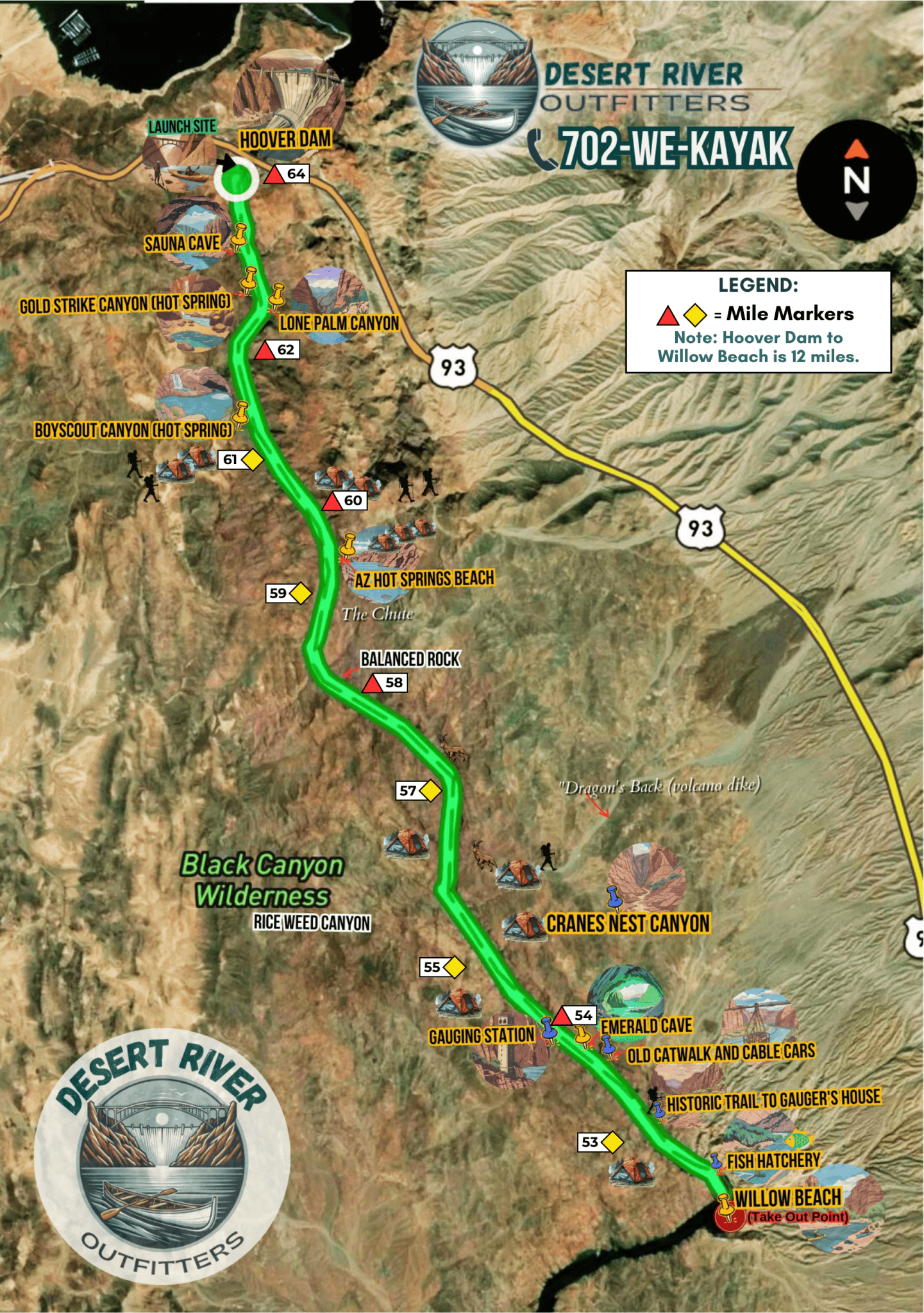
If you don’t have time (or permits) for a full descent, a great alternative is to launch from Willow Beach and paddle upstream to key highlights like Emerald Cave, the Gauging Station, and Sauna Cave, then return the same day, or set up camp and return the next morning.
These out-and-back routes from Willow Beach can be great for day trips or casual overnights. But keep in mind: paddling all the way to Sauna Cave and back in a single day would mean covering 22 miles round-trip, much of it against current and potential headwinds. It’s a demanding route, best suited to very strong paddlers or those planning an overnight. For most people, a more modest out-and-back still offers stunning canyon scenery without the physical toll.
Alternative Route- Paddle from Willow Beach to Eldorado Canyon
- Distance: ~30 miles from Hoover Dam to Eldorado Canyon (17+ miles beyond Willow Beach)
- Experience Level: Intermediate to advanced paddlers only
- Considerations:
- The river widens after Willow Beach and can be more exposed to wind and motorboat traffic.
- There are fewer camping options, and amenities become sparse.
- Must coordinate a custom take-out shuttle—not all outfitters offer pick-up at Eldorado.
Our Favourite Stops
Sauna Cave
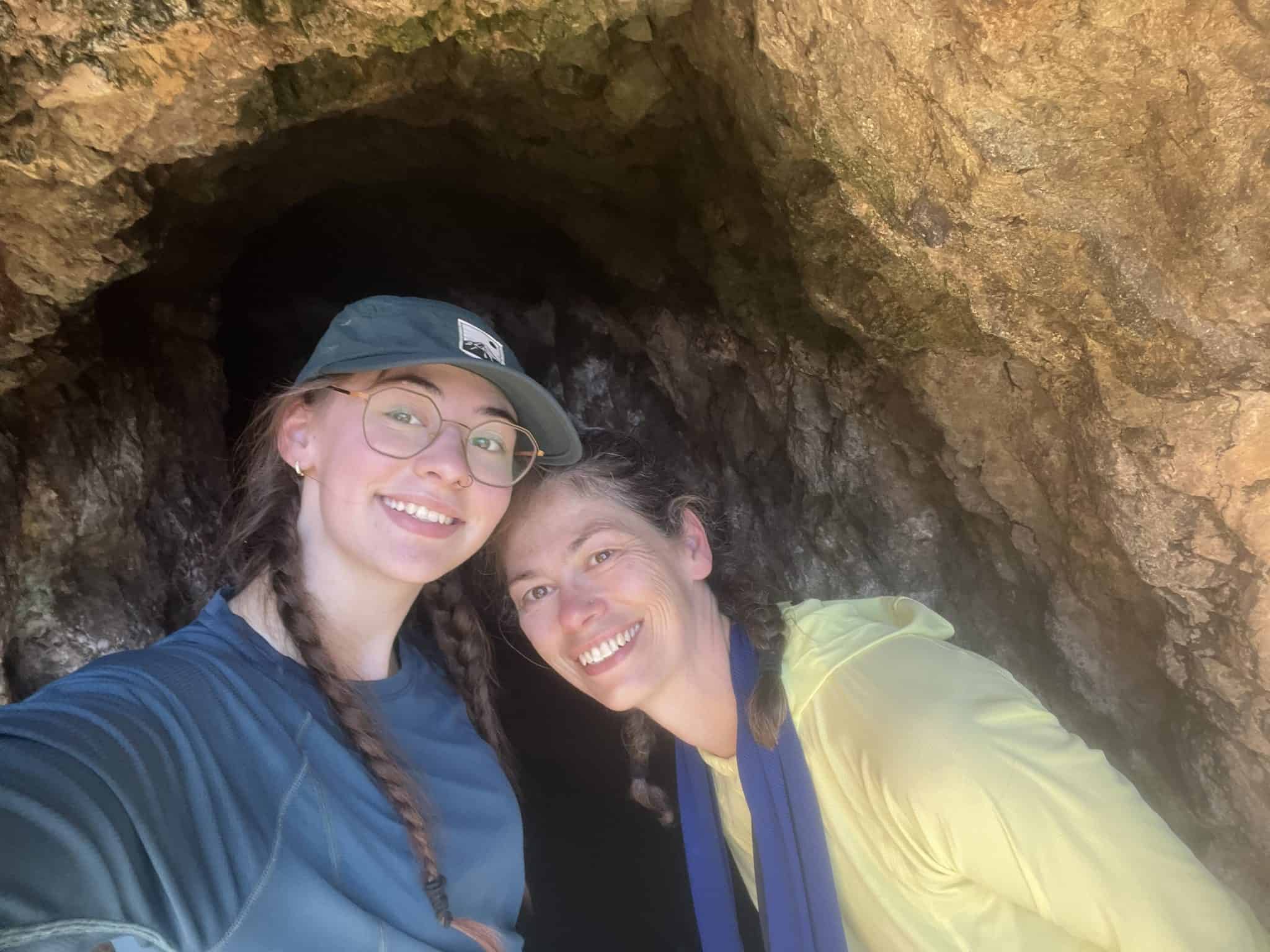
Sauna Cave is one of the most unique and atmospheric stops along the Black Canyon National Water Trail. Located less than a mile downstream from Hoover Dam, this narrow man-made tunnel leads deep into the canyon wall, where geothermal activity heats the air and water inside.
The cave lives up to its name—steamy and humid with water temperatures hovering around 100°F (38°C), creating a natural sauna effect. The further into the tunnel you go, the hotter and more humid it gets. At the end of the tunnel, it feels like a literal sauna!
The short walk inside (bring a flashlight!) reveals mineral-streaked walls, warm pools, and an otherworldly stillness. It’s a surreal stop that combines the Colorado River’s natural beauty with a touch of industrial history—the cave was originally drilled during exploratory work for Hoover Dam.
📌 Pro Tip: Be cautious—footing inside the cave can be slippery, and the heat and humidity can be intense. It’s worth the stop, but don’t linger too long if you’re sensitive to heat or claustrophobic.
Goldstrike Canyon and Nevada Hot Springs
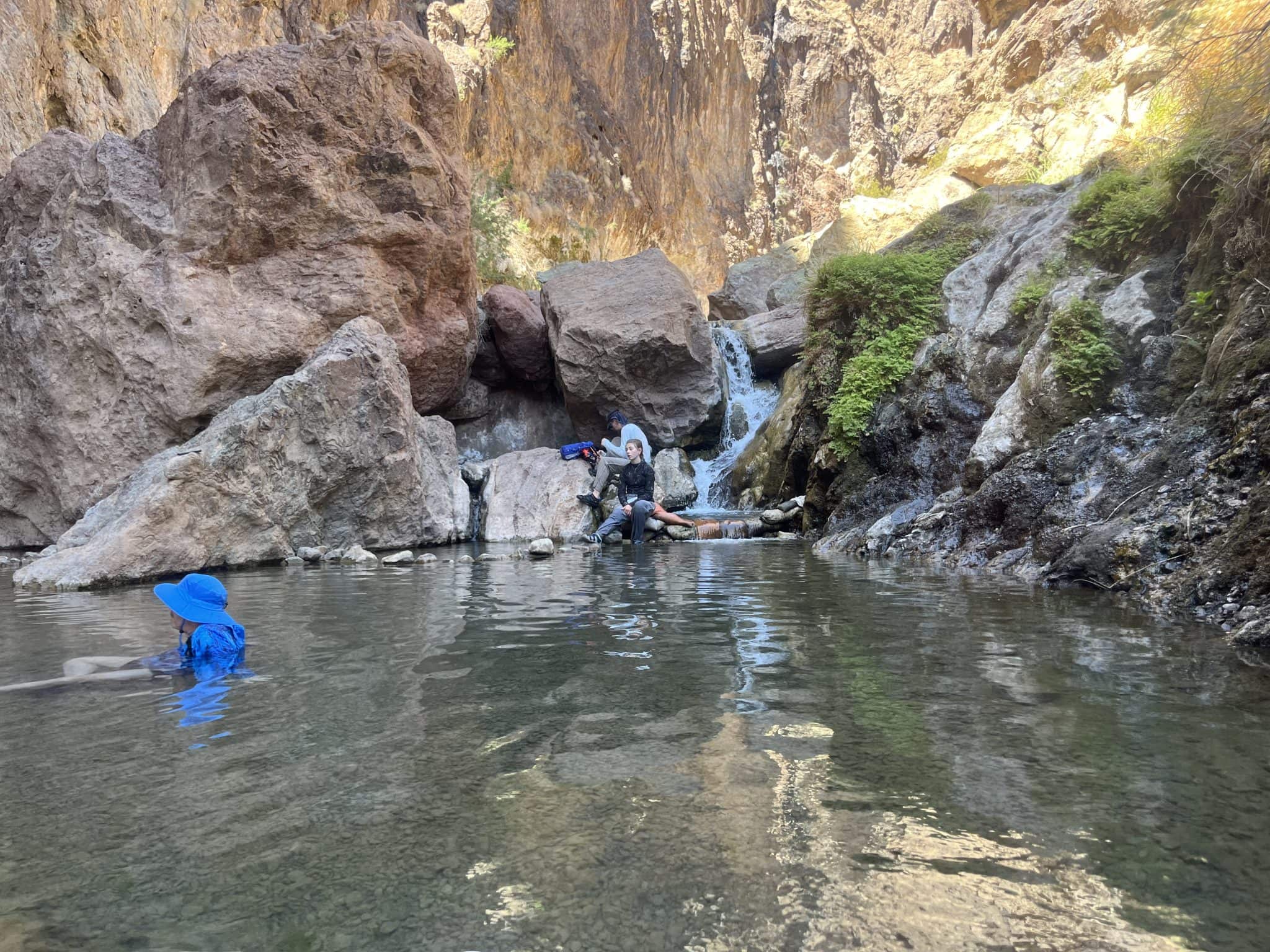
Goldstrike Hot Springs was our second stop along the Black Canyon. Located a few miles downstream from Hoover Dam, this spot is marked by a rocky shoreline where a short but steep scramble leads into a narrow slot canyon. Tucked within the canyon walls are a series of thermal pools fed by hot waterfalls, steam vents, and trickling cascades. Some pools are shallow and steamy, while others are deep enough for a relaxing soak, all surrounded by dramatic red rock cliffs.
While most people reach Goldstrike via the strenuous hike from U.S. Highway 93 (a route that requires ropes and is closed in summer), paddling in from the river is a far more relaxing—and scenic—way to experience it.
📌 Pro Tip: Wear sturdy shoes or sandals with grip. The rocks can be hot, slippery, and sharp.
Jaimie’s Favourite- Lone Palm Hike
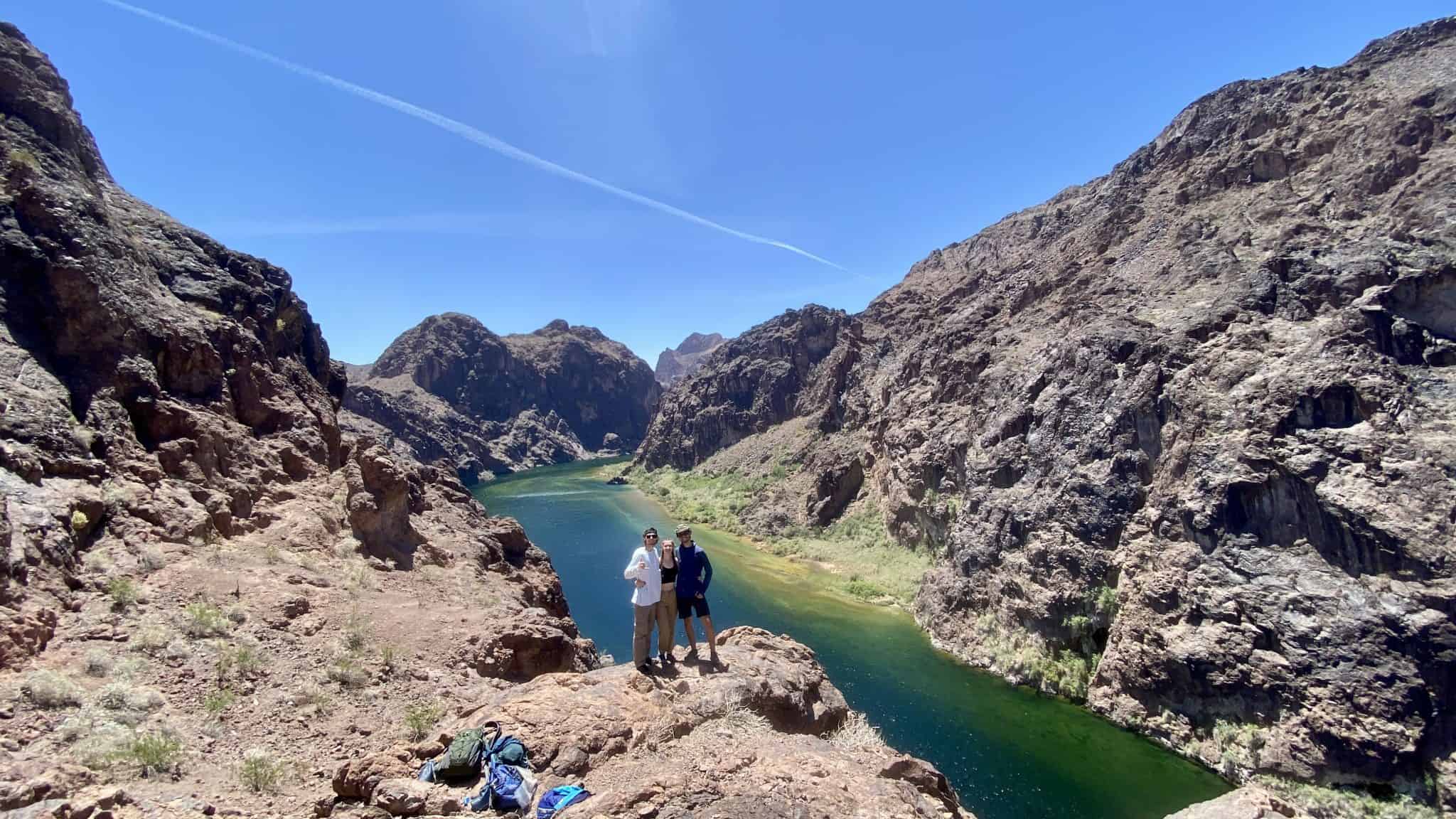
Lone Pine Hike is a short but steep trail that climbs from the banks of the Colorado River up to the rim of Black Canyon, offering dramatic panoramic views along the way. The route begins near a lone palm tree (hence the name) and quickly ascends through loose shale, desert scrub, and exposed rock.
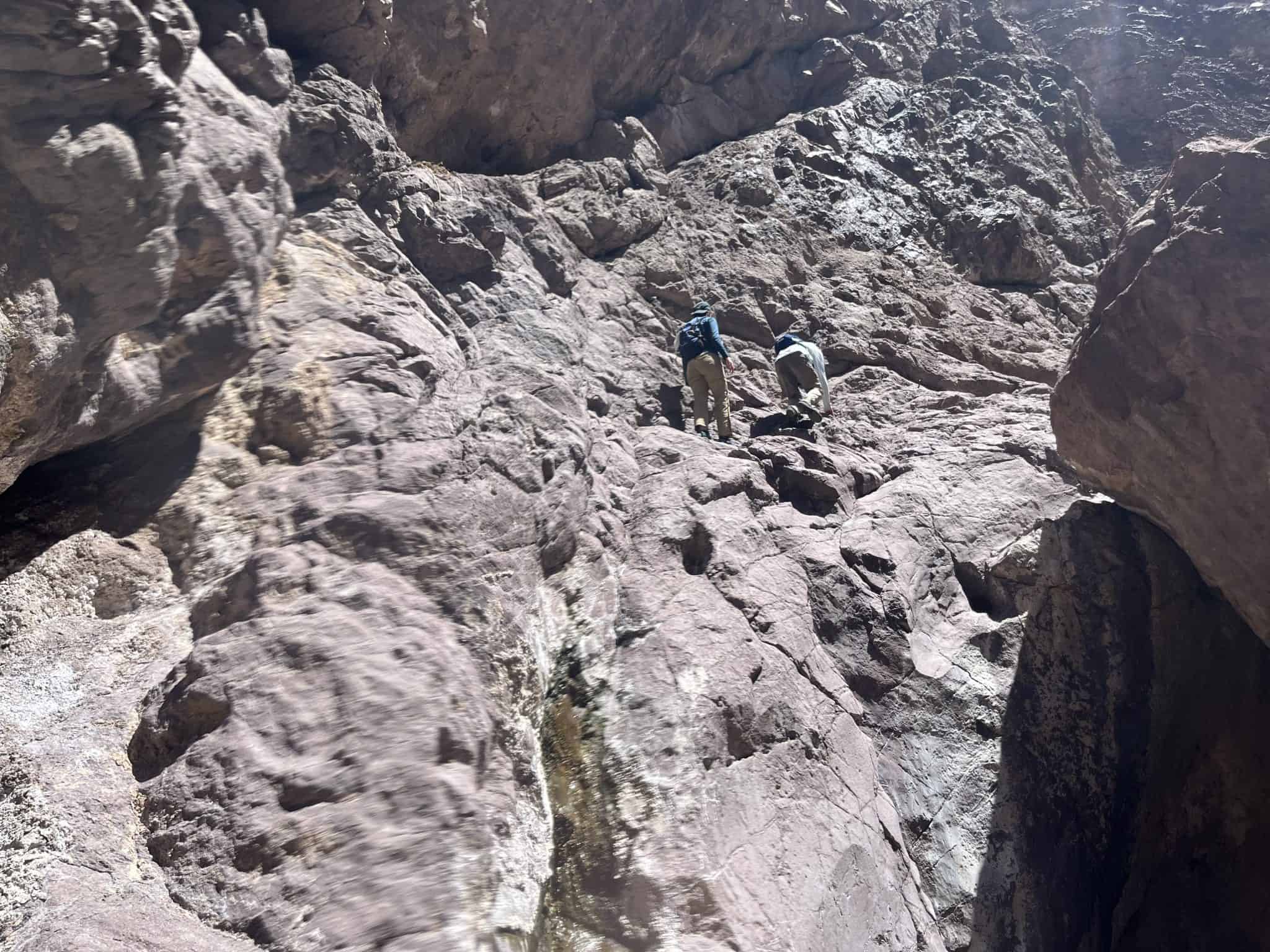
Though less than a mile round trip, the combination of elevation gain, scrambling, hot rock, and slippery footing makes this a moderately challenging hike with some sketchy moments. But the payoff? Sweeping views of the canyon walls, the emerald ribbon of the Colorado River below, and the vast Mojave Desert stretching to the horizon.
📌 Pro Tip: Bring a pair of gloves to protect your hands from the hot rocks when scrambling up and down this trail.
Sarah’s Favourite- Boy Scout Canyon
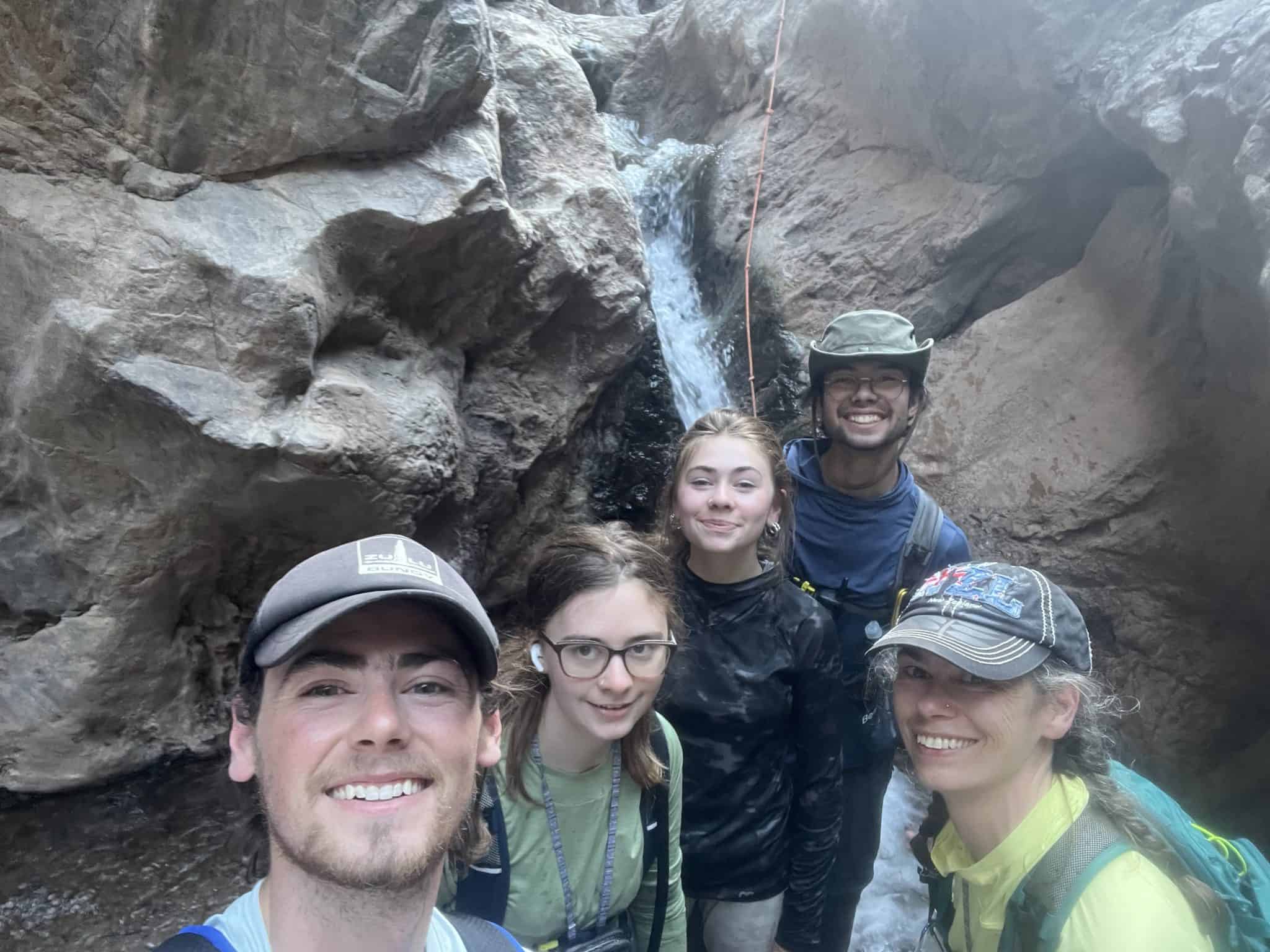
Boy Scout Canyon is an adventurous hike that begins at the Colorado River and winds through a narrow slot canyon, ending at a natural amphitheatre. Along the way, you’ll encounter flowing waterfalls, warm spring-fed streams, and sections that require scrambling. Seven fixed ropes are anchored along the canyon walls to help navigate the steeper spots, making the ascent both challenging and fun. The final push is a 15-foot climb up a rock wall—rewarding those who reach the end with a unique and rugged desert oasis.
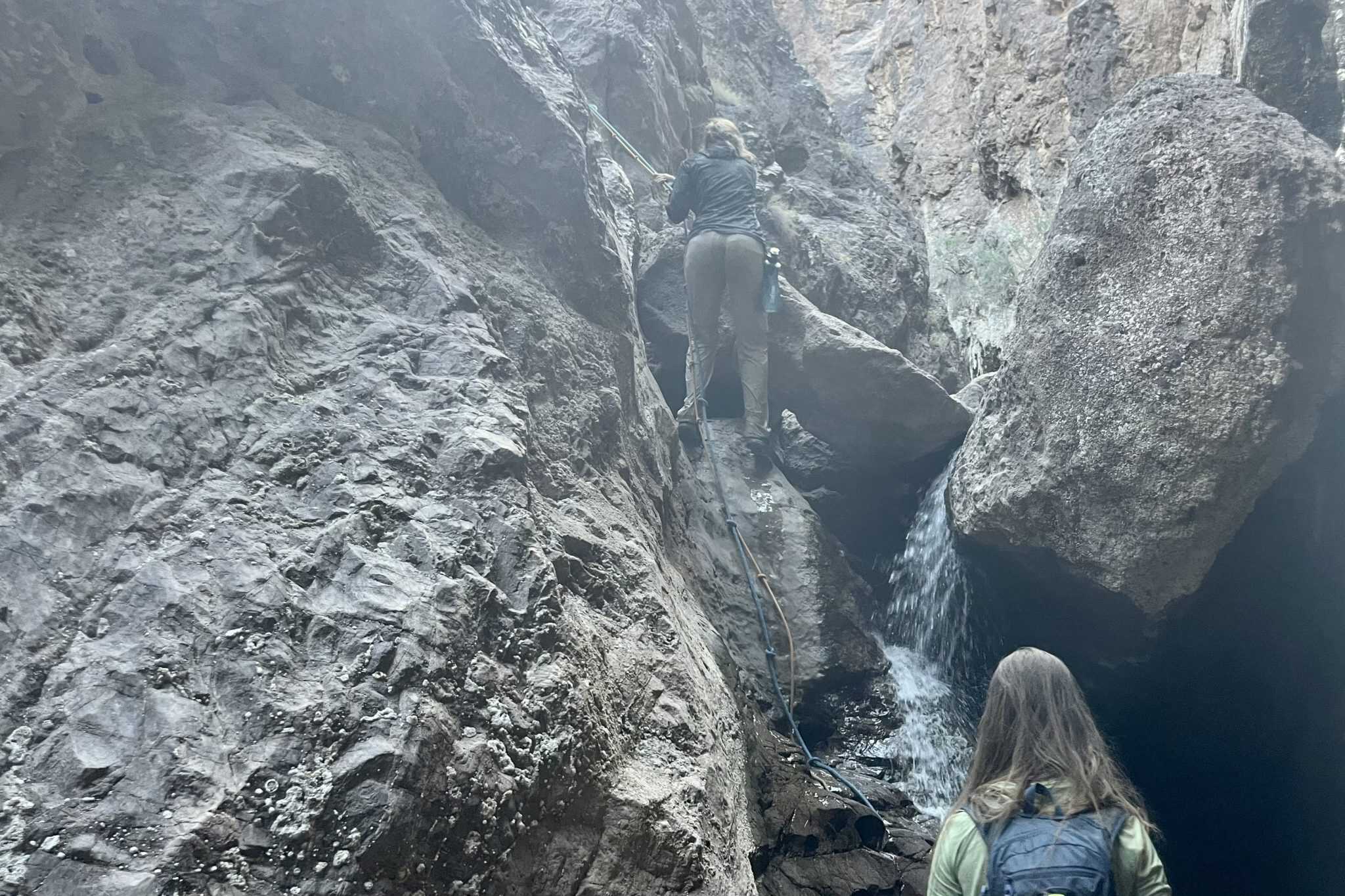
Boy Scout can also be accessed from the highway via a 347 foot rappel down the cliff face or an approximately 2 mile scramble. However you access Boy Scout, it is sure to deliver an adventure.
Craig’s Favourite- Arizona Hot Springs
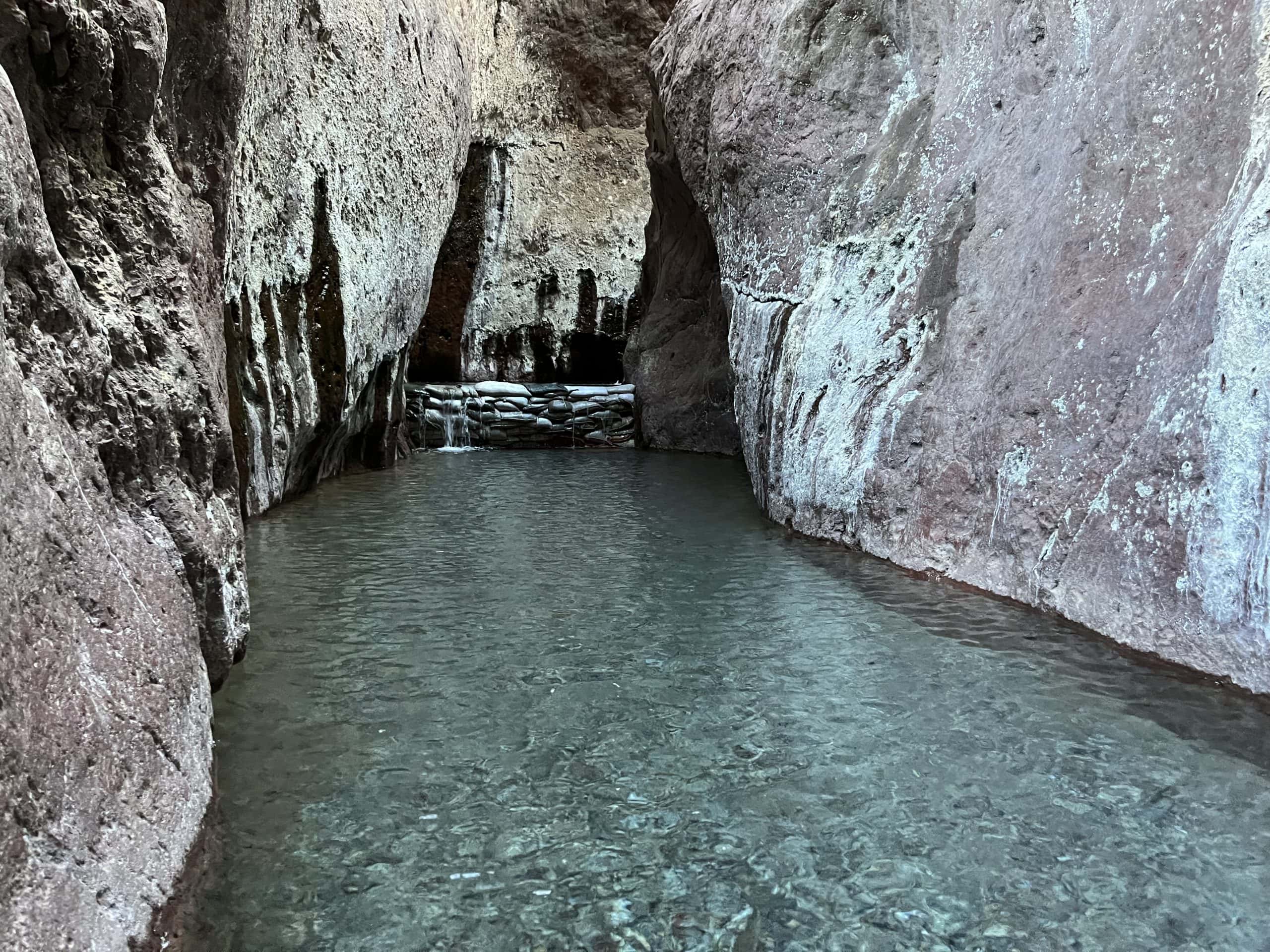
We set up camp at Arizona Hot Springs (also called Ringbolt Hot Springs) our first night. This is the most popular camping spot along the route because it is the only place in Black Canyon with any type of bathroom facility. The composting pit toilets are well maintained and stocked with toilet paper.
This natural oasis features a series of three increasingly hot, tiered pools fed by geothermal springs. A ladder leads up a small waterfall to reach the soaking tubs, which are dammed with sandbags to create relaxing pools of varying temperatures. Use extreme caution if entering the top pool as it can reach temperatures of 110° F or even higher.
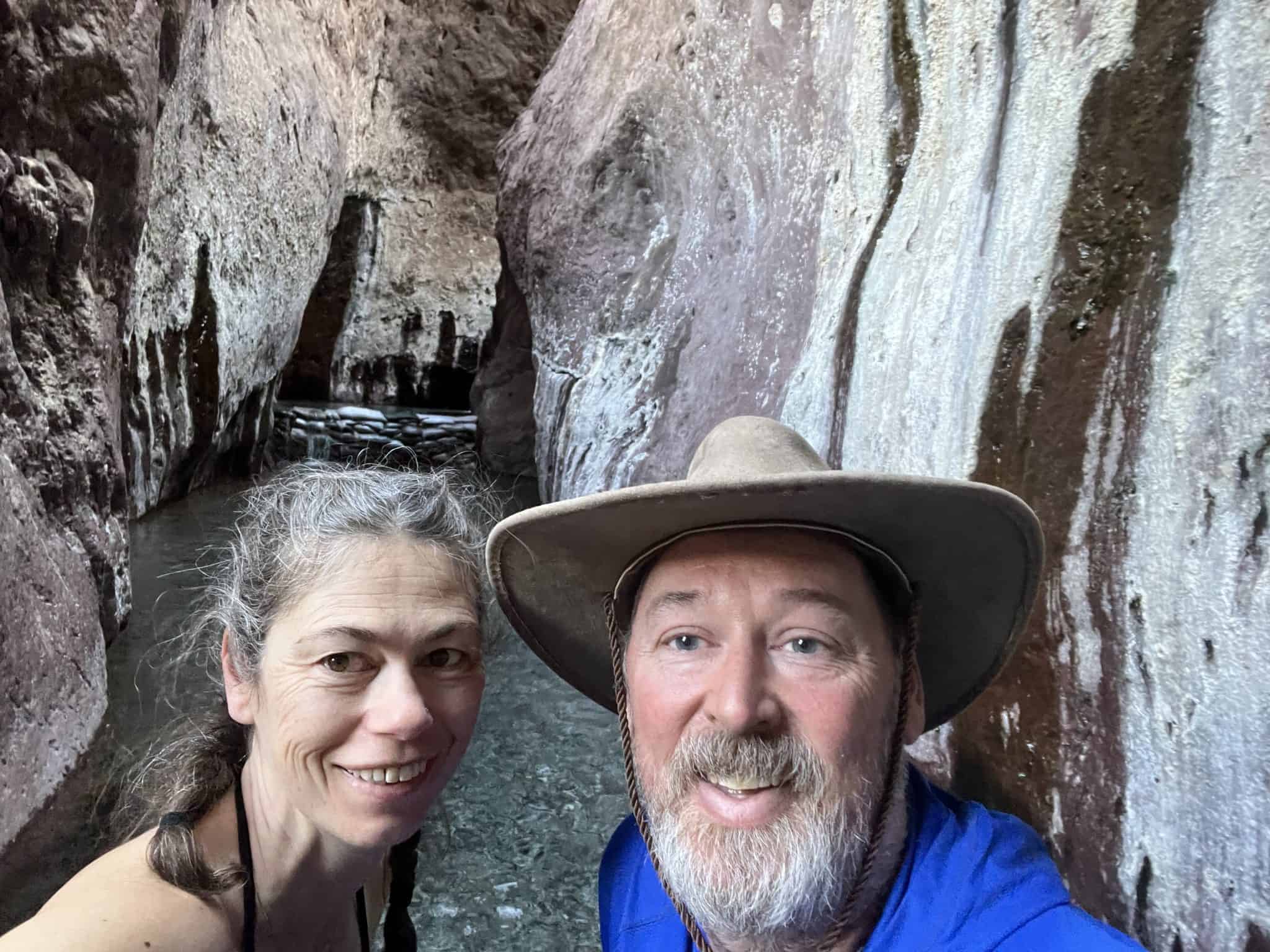
We found the evenings already to warm to consider entering the hot pools, but by morning the temperatures had dropped, and it was a relaxing start to our morning.
The springs are also accessible by a 6-mile round-trip hike from Highway 93.

Daniel’s Favourite- Crane’s Nest Canyon
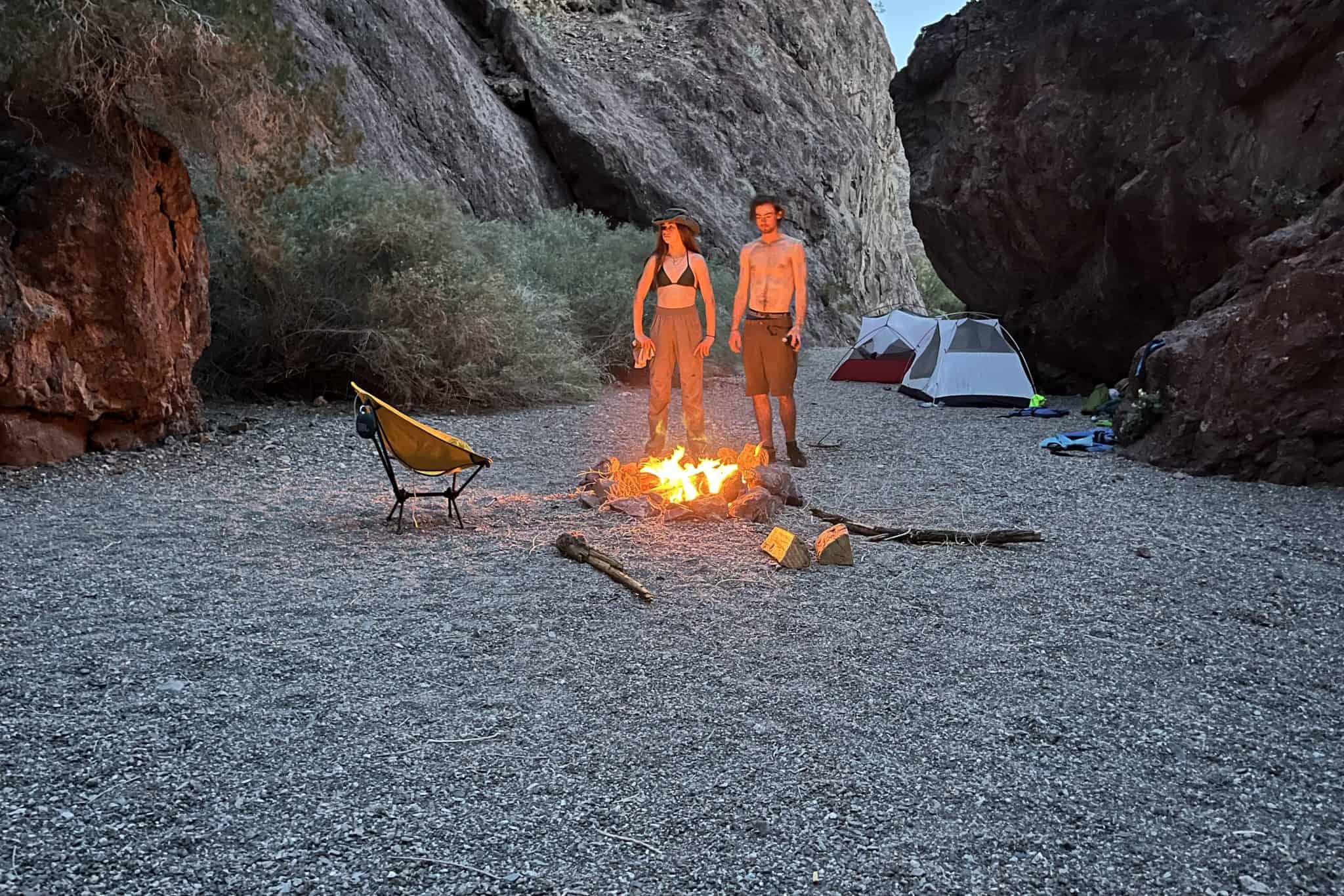
Crane’s Nest was our campsite on the second night, and it felt like our own private oasis. With only two other people camped out of sight, we had the place practically to ourselves. After a long, wind-battered day of paddling, relaxing under the stars by a crackling campfire was exactly what we needed. We got lucky—someone had left behind a small stash of firewood. Marshmallows and a round of bush pies is the perfect way to end of the night.
📌 Pro Tip: Don’t count on finding leftover firewood. This was the only site where we saw any. If you’re on a self-guided trip and want to enjoy a campfire, be sure to pack in your own firewood—and remember, gathering wood (even dead wood) on site is prohibited.
Joshua’s Favourite- Cliff Jumping
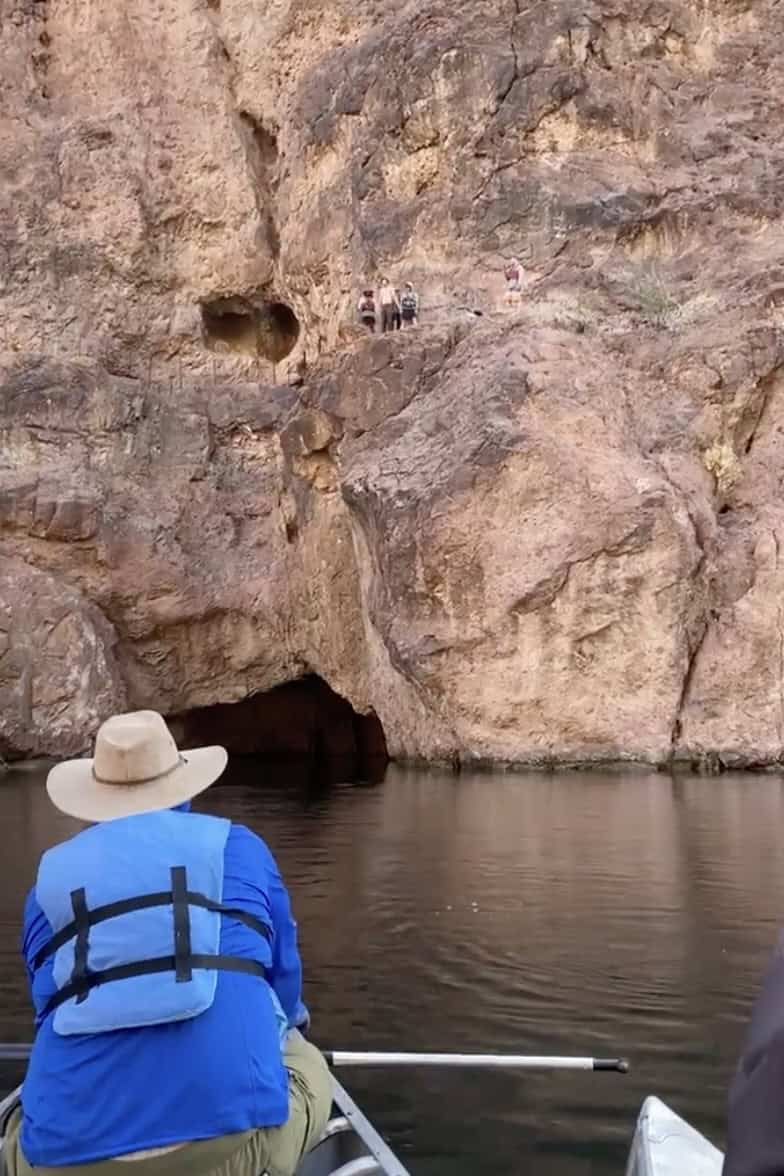
Cliff jumping is a popular thrill for some paddlers in Black Canyon (did I mention this was Joshua’s favourite?)—but it’s not officially recommended by the National Park Service due to safety concerns.
That said, you’ll likely see people leaping from rock ledges into the emerald water, especially near popular stops like Arizona Hot Springs or Boy Scout Canyon. This spot is near Emerald Cave.
⚠️ Safety Tip: If you choose to jump, use extreme caution. The water may look deep, but submerged rocks and shifting currents can pose serious hazards. Always check the depth carefully, and never jump alone. Even experienced swimmers can run into trouble in cold water or around unexpected rocks or wind.
If you choose to jump, use extreme caution. The water may look deep, but submerged rocks and shifting currents can pose serious hazards. Always check the depth carefully, wear your PFD, and never jump alone. Even experienced swimmers can get injured or caught off guard in cold water or unexpected wind gusts.
Emerald Cave
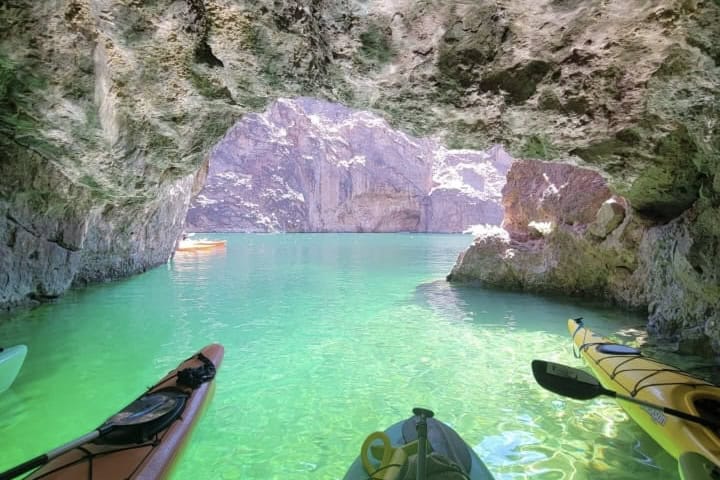
Emerald Cave (also known as Emerald Cove) is an iconic stop on the Black Canyon—and it’s only accessible by water. Located about 2 miles upstream from Willow Beach, this small riverside grotto is famous for the glowing emerald hue of its water. The effect is created when sunlight filters into the cave and reflects off algae-covered rocks beneath the surface. It’s a short but unforgettable stop, especially when the light is just right.
📌 Pro Tip: To see the glow, you’ll need to paddle into the cave and look back out toward the river. The best light usually hits between mid-morning and early afternoon.
Camping Along the Way
There are no formal campgrounds or designated camping sites along the Black Canyon Water Trail, but dispersed camping is permitted—and there are plenty of scenic options. Popular overnight spots include Arizona Hot Springs, Goldstrike Canyon, Boy Scout Canyon, and Crane’s Nest, as well as several beaches and sheltered coves along the river.
While you’re allowed to camp almost anywhere above the high water line, using previously established sites is strongly encouraged to minimize environmental impact. Avoid setting up on islands, sandbars, or too close to the riverbank, as water levels can rise quickly and flood your camp.
📌 Pro Tip: Always secure your boat well when leaving it unattended—changing water levels or wakes from other paddlers can sweep gear and boats downstream.
Keep in mind that there are no trash facilities along the route, and all waste—including toilet paper and human waste—must be packed out. Only Arizona Hot Springs has a vault toilet, so come prepared with wag bags or a portable toilet system.
Essential Gear for Overnight Trips
Although we saw some groups with pretty elaborate camps, we kept things simple—bringing the exact same packing list we used for our Havasupai backpacking trip.
📌 Pro Tip: The amount of gear you can bring depends on whether you’re paddling a canoe or a kayak. Kayaks have limited storage space, so unless you’re going ultra-light, it’s a good idea to include at least one canoe in your group to carry shared gear and bulkier items.
💤 Sleep System: Rest Well on the River
Even after a long day of paddling, it can be hard to sleep if you’re cold or uncomfortable—especially in the desert, where temperatures can drop sharply at night. You won’t be hiking in with your gear like on a backpacking trip, but you still need to keep things compact and protected from water. Choose a sleep system that balances warmth, packability, and durability in a river environment.
🏕️ Tent
MSR Hubba Hubba 2-Person
💰💰💰 Lightweight, durable, and easy to set up
👉 Buy at: REI |
🛏️ Sleeping Bag
🔹 Naturehike CW280
💰💰 Budget-friendly summer bag
👉 Buy at: Amazon
🔹 REI Co-op Magma 30
💰💰💰 Ultralight bag for colder spring and fall nights
👉 Buy at: REI
Sleeping Pad
Big Agnes Rapide SL Insulated
💰💰 Warm, quiet, and compact
👉 Buy at: REI | Amazon
NEMO Tensor Insulated
💰💰💰 Lightweight, comfortable, and quiet
👉 Buy at: REI
Pillow
Nemo Fillo
💰💰Lightweight, packs down small
Buy at: REI | Amazon
Dry Bags
There’s nothing worse than crawling into a wet sleeping bag at the end of a long paddling day. Even if your boat doesn’t capsize, water has a sneaky way of finding its way into canoes and kayaks. Protect your sleep system by packing it in a high-quality dry bag—you’ll thank yourself when you’re warm, dry, and cozy at camp.
Sea to Summit Dry Bags
From your sleeping bag, to your phone, to the next day’s clothes, keep it all protected and organized in dry bags.
💰💰 Lightweight and waterproof
👉 Buy at: REI | Amazon
Hydration
Proper hydration during any desert adventure is critical, particularly during the extremely hot summer months.
1L bottle
Ideal for mixing electrolytes or as a quick refill
👉 Buy at: REI | Amazon
Electrolytes
Electrolytes help replace what you lose through sweat and can help prevent dehydration, cramps, and fatigue. Always keep some on hand.
- Liquid I.V. – Great taste, strong electrolyte profile
👉 Buy at: Amazon - Nuun Tablets – Easy to pack, less sugar
👉 Buy at: Amazon
Water Filter
Necessary even during day trips to keep you well hydrated. We used both filters: the 4.0 litre at night for cooking and filling hydration bladders and the 1.0 litre on the water for quick refilling.
Sun Protection
Sun protection is absolutely essential in Black Canyon. With little natural shade, the sun reflects off the water and canyon walls, intensifying UV exposure. Sunscreen, sunglasses, a wide-brimmed hat, and sun-protective clothing aren’t optional—they’re your best defence against heat exhaustion and serious burns.
- Sunscreen
👉 Buy at: Amazon - Lip balm with SPF
👉 Buy at: Amazon - Sunglasses with UV protection
- Hat preferably wide brimmed
Do not underestimate the desert sun- especially in summer.
Daytime highs in Black Canyon during the summer often soar above 100°F (38°C), with the canyon walls intensifying the heat due to reflected sun and lack of shade. The intense sun exposure and dry desert air mean dehydration and heat exhaustion are real risks—especially when paddling or hiking. Nights can cool off a bit, but it’s often still quite warm after sunset
📌 Pro Tip: Headaches, dizziness, nausea, or confusion can be early signs of heat exhaustion. Take breaks in the shade when you can, soak your clothes or hat in the river, and cool down regularly.
Clothes
In the canyon you’ll need lightweight and quick drying clothes that you can layer. Expect the evenings to be much cooler than the daytime. Avoid cotton as it an take a long time to dry and weigh you down.
Brands we love:
- Outdoor Research
- Columbia
- REI
For All Seasons
- ✅ Moisture-wicking shirt (short or long sleeve)
- ✅ Lightweight pants or shorts (quick-dry)
- ✅ Sun hoodie or long-sleeve SPF shirt
- ✅ Sports bra / underwear / base layers (quick-dry)
- ✅ Water shoes or sandals (Teva, Chaco, or Crocs)
👉 Teva Omnium sandals Buying at: Amazon - ✅ Moisture wicking toe socks
👉 CoolMax Buy at: Amazon - ✅ Buff or neck gaiter (for dust or sun)
☀️ Add for Summer (June–August)
- ✅ Extra moisture-wicking top (you’ll sweat a lot)
- ✅ Cooling towel– essential for staying cool
👉 Buy at: Amazon - ✅ Light sleepwear (shorts + tee or tank)
📝 Expect hot days (90–110°F / 32–43°C) and warm nights (65–75°F / 18–24°C). Hydration and sun protection are your top priorities.
🍂 Add for Spring/Fall (March–May / September–October)
- ✅ Light puffy jacket or fleece
👉 Men’s Columbia fleece Buy at: Amazon
👉 Women’s Columbia fleece Buy at: Amazon - ✅ Thermal long sleeve or base layer
- ✅ Light gloves (optional for chilly mornings)
Food & Cooking
One of the perks of paddling the Black Canyon—especially if you’re using a canoe—is the flexibility in what food you bring. Unlike backpacking trips where every ounce counts, you’ve got a bit more freedom here.
If you’re in a canoe, you can pack a cooler and go full front-country style with fresh food, snacks, and even a camp stove for cooking real meals. Think bacon and eggs, fresh veggies, or grilled sandwiches.
If you’re kayaking or prefer to keep things light, backcountry-style meals like dehydrated dinners, instant oats, and energy bars work great too.
📌 Pro Tip: Before you start paddling, prep a hot lunch and pack it in a high-quality food thermos. After hours of paddling, there’s nothing better than opening your pack to find a warm, ready-to-eat meal waiting for you when you stop.
They are lightweight, durable, and keep your food warm for hours.
Buy at: REI | Amazon
And don’t forget: everything you pack in—including food scraps and trash—must be packed out. Critters are persistent, and Leave No Trace is the rule.
Safety Notes
Monsoons and Storms (mid-June through September):
- Flash flooding is a serious risk, especially in slot canyons like Goldstrike or Boy Scout. Always check the forecast, and avoid narrow canyons if there’s any chance of storms.
- Afternoon storms are common, so try to paddle early in the day and have a safe camp set up before weather rolls in.
- Lightning strikes are dangerous in open areas and near water. If a storm hits, get off the water and avoid exposed high points or isolated trees.
- Storm runoff can turn hot springs murky, or raise bacteria levels temporarily—especially Arizona Hot Springs.
📌 Pro Tip: Before your trip, monitor the National Weather Service’s Lake Mead forecast and consider using a satellite communicator (like a Garmin inReach) to receive weather updates while off-grid.
- Winter and early spring storms (especially from November through March) can bring cold rain, gusty winds, and even hail. While the risk is lower than in summer, flash floods are still possible—especially in narrow slot canyons like Goldstrike, Boy Scout, and Arizona Hot Springs.
- Localized thunderstorms can develop any time of year, particularly during transitional months like April and October. These storms can drop a lot of rain in a short time, increasing the risk of sudden flooding.
- Even if it’s not raining where you are, runoff from upstream can trigger dangerous surges. That’s why it’s critical to understand and prepare for flash flood safety—especially if you’re hiking in canyons with limited escape routes.
📌 Pro Tip: Always check the forecast for the broader area, not just your launch point. If there’s even a slight chance of storms, avoid committing to narrow canyons or exposed washes.
Winter in Black Canyon: What to Know
While winters are mild compared to many parts of the country, they can still pose serious risks if you’re not prepared:
- Cold Water: The Colorado River stays cold year-round—typically around 53–55°F (12–13°C). In winter, immersion can quickly lead to hypothermia. Dress in quick-dry or insulating layers, and avoid cotton.
In colder seasons, consider neoprene layers or a wetsuit if you plan to be in the water for any length of time. - Cold Nights: Daytime temps can be pleasant (50–70°F / 10–21°C), but overnight lows often drop near freezing. Bring a warm sleeping bag (rated at least 0–5°C/32–41°F) and an insulated sleeping pad.
- Shorter Days: With early sunsets, plan to set up camp before dark and pack a reliable headlamp and extra batteries.
- Weather Shifts: Though winter is drier, occasional rain or windstorms can blow through. Bring layers and waterproof gear.
📌 Pro Tip: Even in winter, bring sun protection—UV rays reflect off water and canyon walls year-round.
General Safety and Tips
- Hydrate more than you think you need.
The dry desert air pulls moisture from your body faster than you realize. Start hydrating the day before your trip, and aim to drink regularly—even if you don’t feel thirsty. - Don’t underestimate the wind.
Although the water is mostly flat, desert winds can be intense and unpredictable. Paddle early in the day if possible, and be ready to adjust your pace or plans if gusts pick up. - Secure your gear.
Dry bags are a must, and everything should be tied down or stowed securely—especially in windy conditions or if waves pick up from motorboat traffic. - Know your limits.
Start with a route that matches your fitness and comfort level. Don’t let the calm waters fool you—Black Canyon can be challenging, especially in headwinds or heat. - Pack out what you pack in.
There are no trash bins or bathrooms (except at Arizona Hot Springs), so bring wag bags, toilet paper, and a trash system. Leave no trace. - Use a navigation aid.
Printed maps and offline GPS apps like Gaia or AllTrails help keep you oriented. Cell service is non-existent, so don’t rely on your phone alone. - Take it slow and enjoy.
One of the best parts of paddling in Black Canyon is the chance to explore hidden beaches, caves, and hot springs. Build in extra time and go at your own pace.
Final Thoughts
Exploring the Black Canyon was an unforgettable experience. I truly can’t say it enough: we are blessed beyond measure to be able to witness the beauty of God’s creation together.
Choosing a self-guided trip was absolutely the right call for our group—but that doesn’t mean it’s right for everyone. When the water is calm, it’s a peaceful float. But when the wind picks up (and it will), it becomes a real challenge. Without our strong paddlers, this trip would have been near impossible for our beginners to manage on their own.
I’m incredibly grateful for this crew—they teach, encourage, protect, and push one another to grow. Adventuring together in wild places like this reminds me again and again how much strength we find in community. The bonds formed on the trail are a powerful reminder that we’re never meant to do life alone. It’s both the community we arrive with and the one we build along the way that carry us through.
The wild has a way of bringing us together. Strangers become teammates. Family becomes a team. And the trail makes us all stronger as we grow, stretch, and carry each other forward.
Other Tours Near Las Vegas
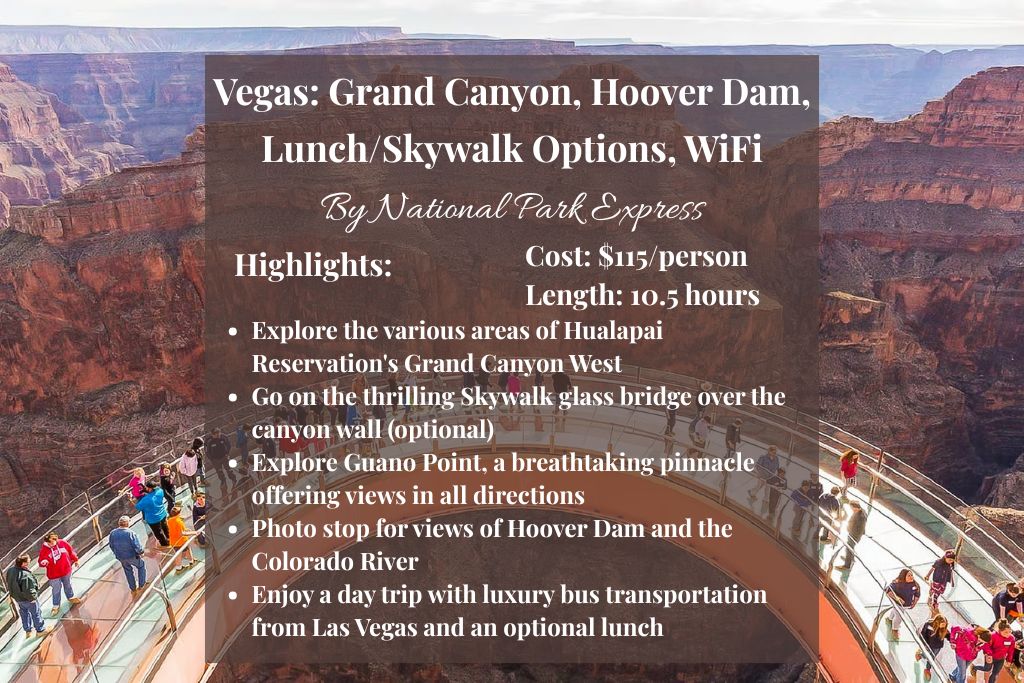
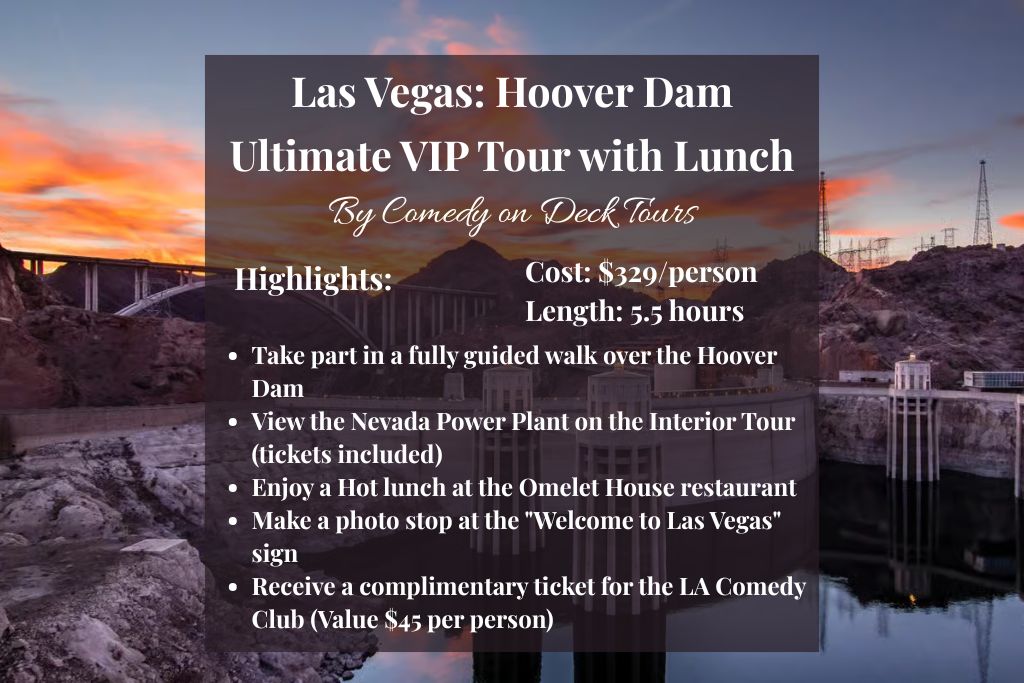
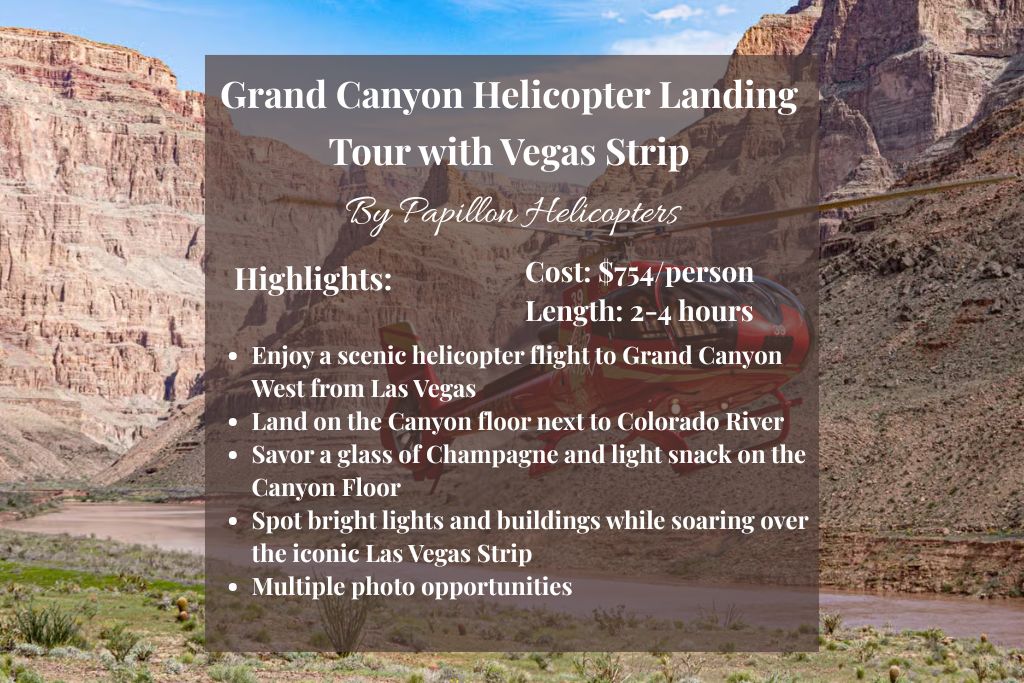
Where to Stay
We stayed at Hoover Dam Lodge in Boulder City the night before our launch, and it was the perfect base for our trip. Our outfitter picked us up right next door, and it was just a short drive to the Hoover Dam launch site. If you’re going self-guided, staying in Boulder City is ideal—close, convenient, and quiet.
If you’re booking a guided trip, check with your tour provider to confirm whether your meeting point is in Boulder City or Las Vegas—some companies operate out of either location.
📍 Where to Stay:
Use the interactive map below to find accommodations that fit your dates, group size, and budget.

